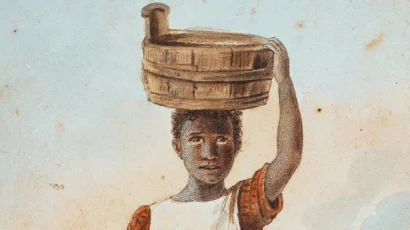Lives Bound Together: Daily Life
This page contains primary and secondary sources on different communities and traditions within the enslaved community at Mount Vernon. Use these resources to learn more about the system of slavery and find useful learning materials.
Explore this in-depth exhibit, included with admission, on your next visit to Mount Vernon.

Plantation Structure
Mount Vernon consisted of five different farms, as well as a gristmill and distillery. All of which had different living situations, work assignments, and communities of people who were enslaved.
Read More about Mount Vernon's plantation structure
Food at Mount Vernon
The enslaved people at Mount Vernon received small amounts of food rations - 1 quart of cornmeal and 5 to 8 ounces of salted fish. Learn more about food rations and how people supplemented their diets.
Read more about Food at Mount Vernon.
Housing
Many people who were enslaved lived in a small cabin alongside up to seven other people or family members. Others lived in larger quarters, sleeping in bunks.
Read about the housing at Mount VernonExplore a Cabin
This reproduction of a slave cabin shows a typical dwelling of an enslaved family or 4-6 adult individuals.
A Day in the Life of an Enslaved Field Worker
Click the link to learn about what a typical day might look like for an enslaved field worker

Field Labor
Some people at Mount Vernon were forced to work in the fields, harvesting crops such as wheat, corn, and turnips.

Skilled Trades
Not all people worked in the field or the Mansion. Some people knew special skills, like making barrels, spinning flax to create yarn, or gardening.

Resistance and Punishment
Many people who were enslaved at Mount Vernon found small and big ways to resist their enslavement. These actions ranged from feigning sickness to seeking freedom.
What did daily life look like for a person who was enslaved at Mount Vernon?
Why might these days look different between individuals in the Mount Vernon enslaved community?
Primary Sources
Use these primary sources to learn more about daily life
- Garden Hoe
- Illustrated Crop Chart
- 1793 Farm Report
- 1793 Illustrated Farm Report
- Slave Cabin
- Blacksmith's Shop
- Spinning Room
- 1793 Spinning Report
- Men's Slave Quarters
- Women's Slave Quarters
- 1793 Carpenter's Report
- Maryland Runaway Slave Advertisement
- The Distillery
- The Gristmill
- George Washington on Ona Judge
- Saucer
- Tobacco Pipe
- Marble
- Teabowl
- Pot Hook
- Colonoware Vessel
- Fishing Weight
- Persimmon Seeds
- Spanish Coin
- The Vaughn Plan
- Watering Pot
- Sundial
Secondary Sources
Use these secondary sources to learn more about daily life
Back to Lives Bound Together Resources
Click the link to go back to the Lives Bound Together home page
Back to Lives Bound Together